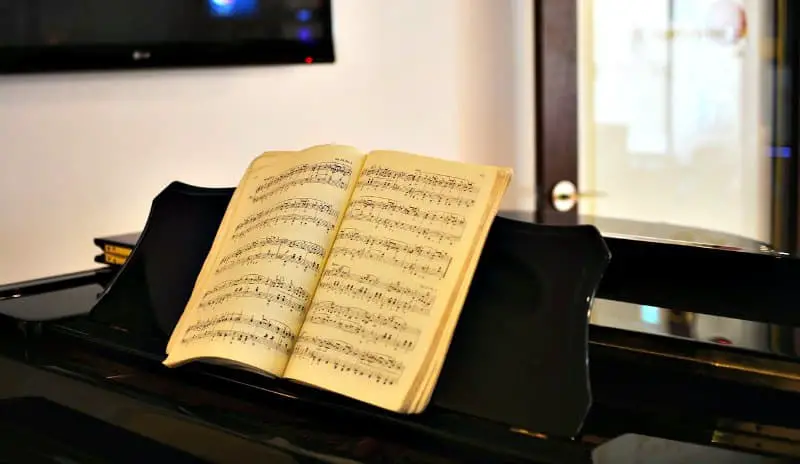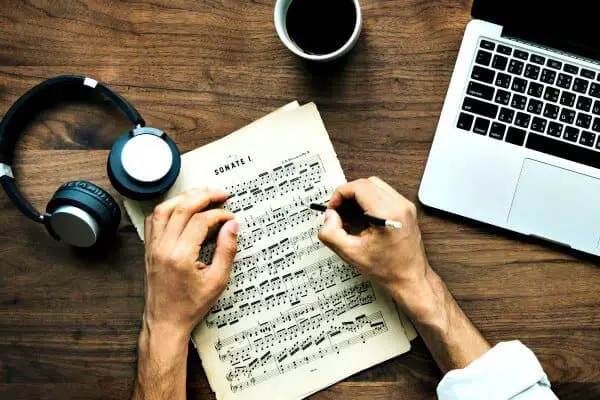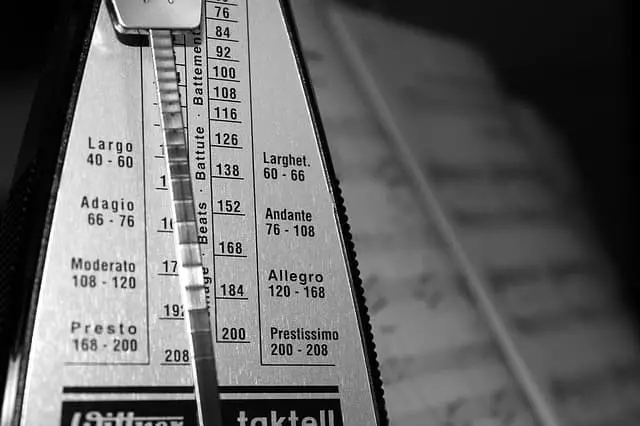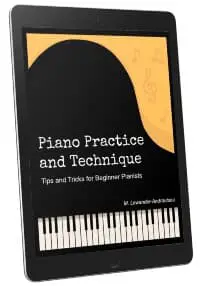- Home
- Piano Practice
- Piano Practice Tips
Piano Practice Tips for Beginners
This article may contain compensated links. Please read the disclosure for more info.
Here are tried and tested piano practice tips and exercises to help you get better results and improve the effectiveness of your practice.
Effective piano practice tips
I like my students to work on several pieces at once. We work on different types of repertoire, etudes, exercises, scales, chords, sight-reading, and chord piano, for example.
This can be a lot of material to work on and can lead to confusion unless the material and the practice time are organized.
 Improve Your Piano Playing with Smart Piano Practice Tips.
Improve Your Piano Playing with Smart Piano Practice Tips.Organized Practice
Let's start the piano practice session with some form of warm-up.
Scales and chord practice, for example. If you are working on any particular exercises for piano technique, do this first as well.
Next comes the study of repertoire.
Your pieces will be in different levels of completion, so to create a sense of where you are with each piece and to quickly assess what needs to be done, the piano practice tips below are of immense help.
I recommend The Musicians Way, a book crammed with great tips and plans for organizing your practice. It has inspired me and my teaching a lot.
Also, The Practice Revolution: Getting great results from the six days between lessons is a fun resource for kids and adults.
Piano Practice Tips: A Plan in 6 Levels
Here are piano practice tips in a plan that you can work with step by step.
Each piano piece will be worked on through 6 different levels:
- Planning and Preparation.
- Hands Separately: Fingers and Movement.
- Hands Together Slowly.
- Hands Together Up-Tempo
- Memorization
- Repertoire Maintenance and Performing.
Level 1: Planning and Preparation
This part of the piano practice is done in your mind, away from the piano.
- With a crisp copy of the music (taped together if more than one page), you will study the music by listening and following along in the score. You can use recordings or check out YouTube.
- As you listen, several times, mark with a pencil any "Aha!" places, like a dynamic mark you didn't notice or something the performer does that you'd like to do too. Also, mark out any repeated parts or patterns.
- Next, divide the piece into parts with a ruler. For example, if the piece is in an ABA- form, mark where every part begins and ends.
- Then divide the piece into smaller parts, either 2-4 measures or in phrases that make sense musically. But the more challenging the music is, the smaller the parts should be.
- Finally, sit in a comfortable chair with the sheet music in front of you and imagine playing the piece as you read the music. If you need to, listen to the music again, but try to do this exercise without any actual sound if you can. Let it "play" in your mind.
Level 2: Hands Separately, Fingering and Movement
Have patience! Even though you now may feel so revved up, you’d love to start playing the piece hands together- DON’T!!
Your goal is to learn each hand separately, slowly, and then at tempo.
- First, focus on the correct notes and fingering. Write out the fingering if necessary, circle any awkward places, and work section by section until you can play slowly without any mistakes.
- Make sure to do the correct dynamics and articulation (staccato, legato, portato).
- Try to feel where each phrase leads, to use the right direction and arm movement.
Once you can play the whole piece hands separately slowly without mistakes, learn how to use a metronome to gradually increase speed a little daily.
Do this until you can play the whole piece hands separately in full tempo.
Level 3: Hands Together, Slowly
Finally, you are “allowed” to play with both hands together. Use this simple formula:
"The speed you can play your hands separately must be halved when playing both together."
This will feel very slow but will make it possible to coordinate both hands without mistakes.
Work each small section by section, coordinating both hands like this:
- First, review each hand separately.
- Then play ½ tempo, or extremely slow, both hands together.
- Repeat several times, but focus on something to improve for each repeat, like articulation, dynamics, direction, and expression.
Master, and then combine the small sections like this:
- Section A (2-4 measures for ex.)
- Section B
- Section A +B
- Section C
- Section D
- Section C + D
Continue until you have learned the whole piece. Then combine the larger sections: A+B and C+D, etc., until you slowly master everything with both hands.
Level 4: Hands Together at Tempo
Again, working with the smaller or medium-sized sections, work with the metronome to gradually build up the tempo until you can play the whole piece in full tempo with both hands.
Congrats! Record or videotape yourself and evaluate what you need to improve.
More Piano Practice Tips: A very successful way of practicing is to use random or interleaved practice. Learn more about an interleaved piano practice routine here.
Level 5: Memorization
Learning to memorize music is easier for some people and more challenging for others.
If you are lucky to belong to the latter category, you will already have learned the piece by heart by now!
For the rest of us, it's back again to the smaller sections...
Although it will be easier now, you must patiently go through each section as you did before. But this time, memorize each hand separately, then both, and rinse and repeat each section as before.
Level 6: Repertoire Maintenance and Performing
Once a piece is memorized, it will only stay that way if you review it occasionally.
- For newly memorized pieces, play at least once a day for a week.
- The following week once every two days.
- The third week is once every three days.
- After that, a few times a week, should keep it ready to play whenever you like!
I hope this gave you some tips on how to practice more effectively!
Share Your Piano Practice Tips Here!
Found a great way to practice? Share your favorite piano practice tips or a practice routine that works well for you. Maybe you can help someone else with a problem? You can also add a helpful comment!
Practice Tips and Solutions
Click below to see piano practice tips, questions, comments, and solutions from other visitors to this page. Do share a helpful comment if you can!
Why After Practicing Do I Make Mistakes When Performing? Not rated yet
I would like to know why after carefully practicing a piece of music and feeling that I have mastered it, I then find myself making mistakes in performance. …





